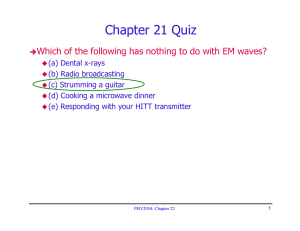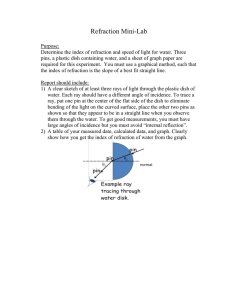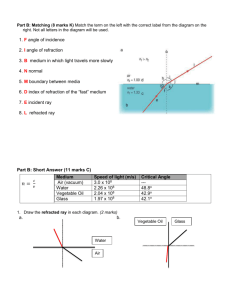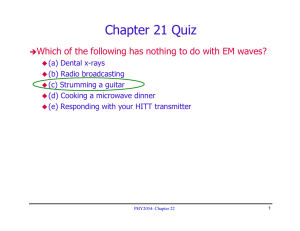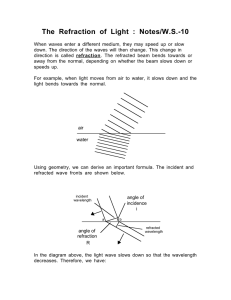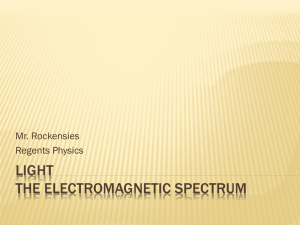Following the Reflected and Refracted Rays Refraction of Light
advertisement
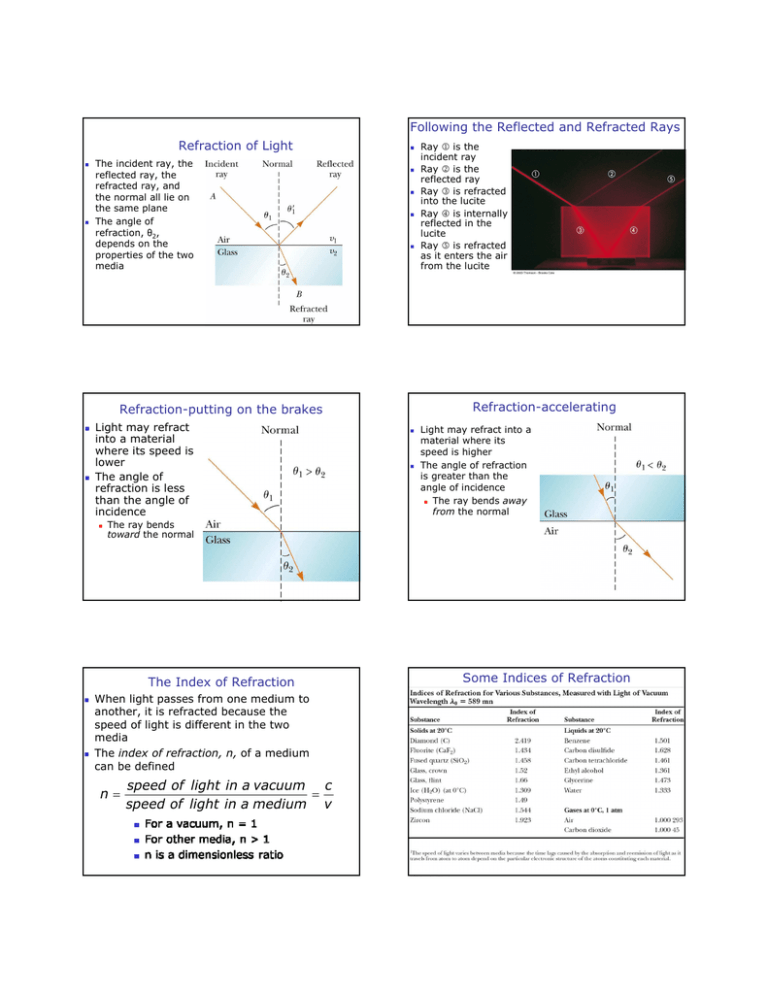
Following the Reflected and Refracted Rays Refraction of Light The incident ray, the reflected ray, the refracted ray, and the normal all lie on the same plane The angle of refraction, θ2, depends on the properties of the two media Refraction-accelerating Refraction-putting on the brakes Light may refract into a material where its speed is lower The angle of refraction is less than the angle of incidence Light may refract into a material where its speed is higher The angle of refraction is greater than the angle of incidence The ray bends away from the normal The ray bends toward the normal The Index of Refraction Ray 1 is the incident ray Ray 2 is the reflected ray Ray 3 is refracted into the lucite Ray 4 is internally reflected in the lucite Ray 5 is refracted as it enters the air from the lucite When light passes from one medium to another, it is refracted because the speed of light is different in the two media The index of refraction, n, of a medium can be defined n= speed of light in a vacuum c = speed of light in a medium v Some Indices of Refraction Snell’s Law of Refraction n1 sin θ1 = n2 sin θ2 θ1 is the angle of incidence Total Internal Reflection 30.0° in this diagram θ2 is the angle of refraction Total internal reflection can occur when light attempts to move from a medium with a high index of refraction to one with a lower index of refraction Ray 5 shows internal reflection Quick Quiz: If n1 =1, n2 =1.5, and sin30=0.5 What is sin θ2 ? A. 1 B. ½ C. 1/3 D. ¼ E. 3 Critical Angle A particular angle of incidence will result in an angle of refraction of 90° This angle of incidence is called the critical angle n1 sin θ1 = n2 sin θ2 n1 sin θ1 = n2 sin θ2 n1 sin θ1 = n2 * 1 sin θ C = Fiber Optics Applications of internal reflection Plastic or glass rods are used to “pipe” light from one place to anothe medical use of fiber optic cables for diagnosis and correction of medical problems Telecommunications Christmas tress n2 for n1 > n2 n1 Dispersion The index of refraction in anything except a vacuum depends on the color of the light This dependence of n on color is called dispersion Light disperses into colors when refracted The index of refraction for a material usually decreases with from violet to red Violet light refracts more than red light when passing from air into a material Responsible for rainbows and all other prism effects Refraction in a Prism The amount the ray is bent away from its original direction is called the angle of deviation, δ Since all the colors have different angles of deviation, they will spread out into a spectrum Violet deviates the most Red deviates the least A ray of light strikes a drop of water in the atmosphere undergoes both reflection and refraction First refraction at the front of the drop At the back surface the light is reflected It is refracted again as it returns to the front surface and moves into the air The Rainbow Observing the Rainbow A ray of light strikes a drop of water in the atmosphere It undergoes both reflection and refraction First refraction at the front of the drop Violet light will deviate the most Red light will deviate the least At the back surface the light is reflected It is refracted again as it returns to the front surface and moves into the air The rays leave the drop at various angles The angle between the white light and the violet ray is 40° The angle between the white light and the red ray is 42° Christian Huygens 1629 – 1695 Best known for contributions to fields of optics and dynamics Deduced the laws of reflection and refraction Explained double refraction If a raindrop high in the sky is observed, the red ray is seen A drop lower in the sky would direct violet light to the observer The other colors of the spectra lie in between the red and the violet


